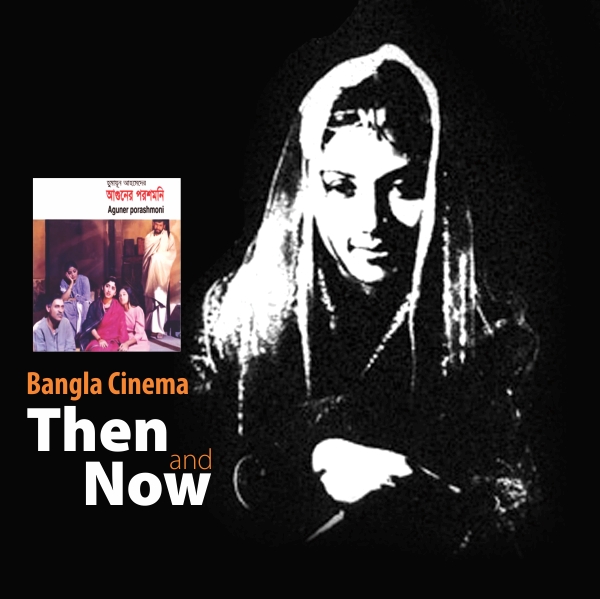
By Orin and Moyukh
While the French and the Italians were experimenting with cinema and giving the world masterpieces, we were never far behind. The art-film and neo-realist film movements left us with brilliant films such as The Bicycle Thief and La Dolce Vita; Felini and Renoir were taking movie making to a whole new dimension and surprisingly the Bangla filmmakers of that time were on a par with them. Even if it's hard to believe, Bangla films have had their share of creative genius who dared to experiment and their avant-garde approach to filmmaking had once given Bangla films world renown. So when we turn on our televisions or walk by cinema halls today, one question pops up: what happened? Let us first take a look at history.
The first film to be made in Bangladesh (then East Pakistan) is said to be 'Mukh of Mukhosh' by Abdul Jabbar Khan. Before that, bioscopes had started in Kolkata which was also common here during the early nineties. The first Bangla film maker is considered to be Hira Lal Sen. While in the subsequent years, both commercial and realist films were created, many have now been lost.
Satyajit Ray is the biggest name to date in Bangla films and has won 11 international awards. Inspired by Renoir and Vittorio De Sica, he took up film making and introduced the concept of art films in Bangla movie making and his use of light and other effects were innovative for that time. Other filmmakers such as Mrinal Sen, Ritwik Ghatak also directed some wonderful movies. People who otherwise would never go near a 'Bangla Cinema', agree that Satyajit was a genius. He was the first to bring radical concepts of that era into Bangla cinema, and watching the scene of the dancing ghosts with the psychedelic music from 'Gupi Gain Bagha Bain' shows us how good they were.

Highly acclaimed by Satyajit and Mrinal Sen, another name in film was Zahir Raihan. His 'Stop Genocide' won the SIDLOC award at the Delhi Film Fest. Subhas Datta's 'Kagojer Nouka', Ritwik Ghatak's 'Titas Ekti Nadir Nam' are also notable titles in Bangla film.
Post liberation film makers focused more on the war and notable among them are Chashi Nazrul Islam with his 'Ora Egaro Jon'. Talking to cinema lovers from back then, one thing is clear, there still were good movies that were being made during the eighties and the early nineties. We had the potential with the limited technology and resources to make films of international acclaim.
A recent article by BBC shows the Bangla movie industry is under threat by the Bollywood films as the audience number has been on a steady decline for quite a while. While Fast Fives and the Twilight sagas bring in the newer generation to the more expensive movie theatres, Bangla movies fail to do so in a spectacular fashion. For a 20 million dollar industry that employs over 100,000 people, the movie industry has managed to produce only a few 'good' movies over the last couple of decades, thanks to the passion and courage of certain movie-makers.
RS talked to some of the movie-goers from the golden days of cinema, and according to them, even though the movie industry suffered a big blow from the death of Zahir Raihan, the movies being made at that time were still decent. Ms. Rokeya, a moviegoer in the 70s and early 80s said, “The good thing about those movies were that they revolved around some social issues, like the youth standing up against a village tyrant, the changes people fought through after moving to the city and there were also a lot of movies made about the independence war. But mostly, no matter what movie it was, they had a feel of that time, something movies these days so severely lack. Going to the movies used to be a family affair back then, and movie days were the highlights of the month.” Another added, “We say that commercial movies are for the masses, and they don't know any better, but the thing is, those people used to see the good movies 20 or 30 years ago; it's not like the masses don't appreciate good work.”
When asked about how they see movies of that time, the younger generation answered the same way. Raisa, a tenth grader, said that cinema back had a certain charm about them; the songs, the storylines however simple, created something we would love to watch any other day, unlike the current movies which we see just to make fun of them.
Times have changed and so has the movie industry, and now is the time when the movie industry is either releasing movies named after every other member in your extended family or with names like 'Garments Konna' and 'Piriter Dokandari'. Unsurprisingly, the educated middle class that used to be the prime audience in 70s and 80s have abandoned the movie halls, making it tougher for the already falling industry.
“The movies of today are made up of plagiarised scripts that show the lack of intellect of the makers with actors that really need to exercise,” says Sabbir, an undergrad student. “The movies show that they are made for the sole purpose of making money which makes them fail at it even more,” He adds. “Low budget and no realism whatsoever adds to that,” Nabil, an HSC student puts in.
Nina, a French friend who has an eclectic taste in culture and art, once asked one of the writers why she disdained Bangla movies. Then she went on to explain about how Satyajit's films were some of her favourites. If films created back then are still so highly thought of among film lovers all over the world, it's a wonder we have managed to fall this far. However, the lack of funding is a factor which needs to be taken into account.
Despite everything, art films are being made today, some of them getting national and international acclaim. The late Tareque Masud was one of the pioneers of independent movies in the country. Tanvir Mokammel, Morshedul Islam, Humayun Ahmed and Mostofa Sarwar Farooki are some of the names that we can count on, but they are independent directors who exist in small numbers and their movies are worlds apart from the commercial movies of today, rarely made for the young people and hardly targeting the same audience as their commercial counterparts. This lack of effort and creativity has made young director Rubaiyat Hossain say, “Without bringing Indian films to the local market, there is no way to revitalise the industry. Actually there is no industry here,” proposing Indo-Bangla joint ventures.
Whatever they can do, be it collaborating with foreign directors or maintaining a strict code to improve the movies, should really be done before the industry goes beyond any help. Because, when we laugh at Bangla movies, we really are laughing at ourselves.
References: BBC News, Wikipedia: Cinema of Bangladesh, www.latrobe.edu
